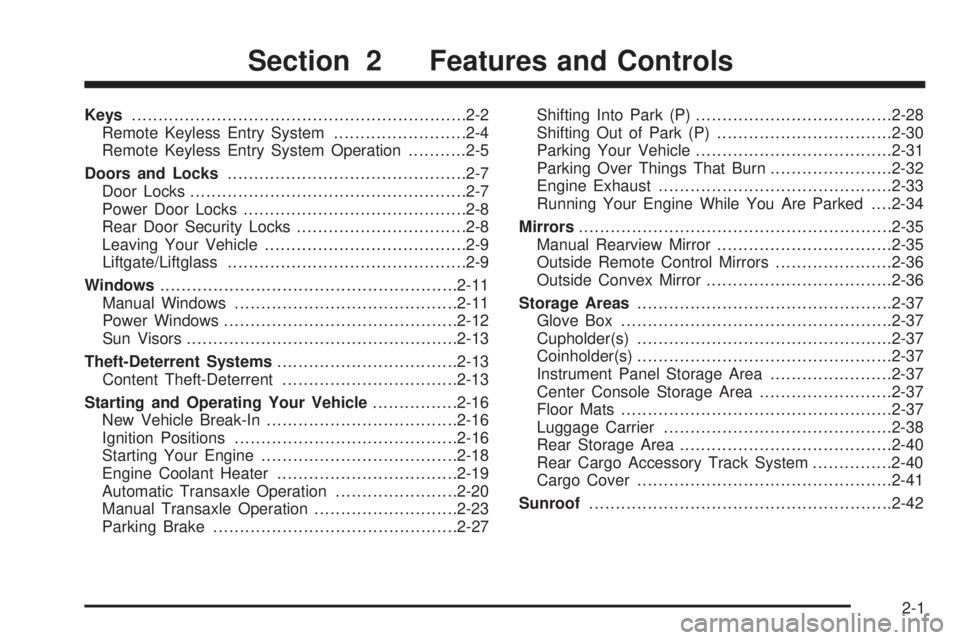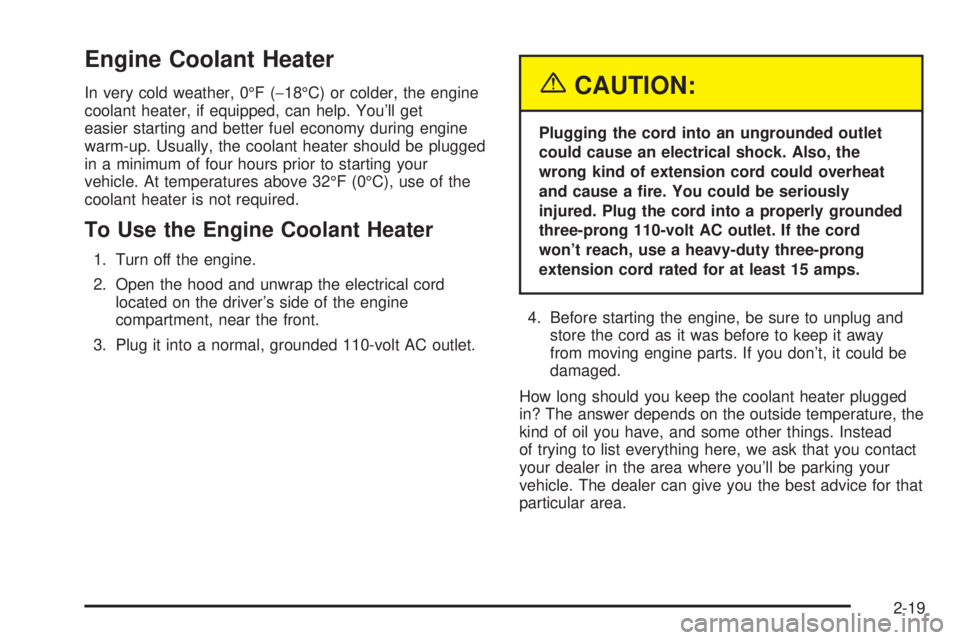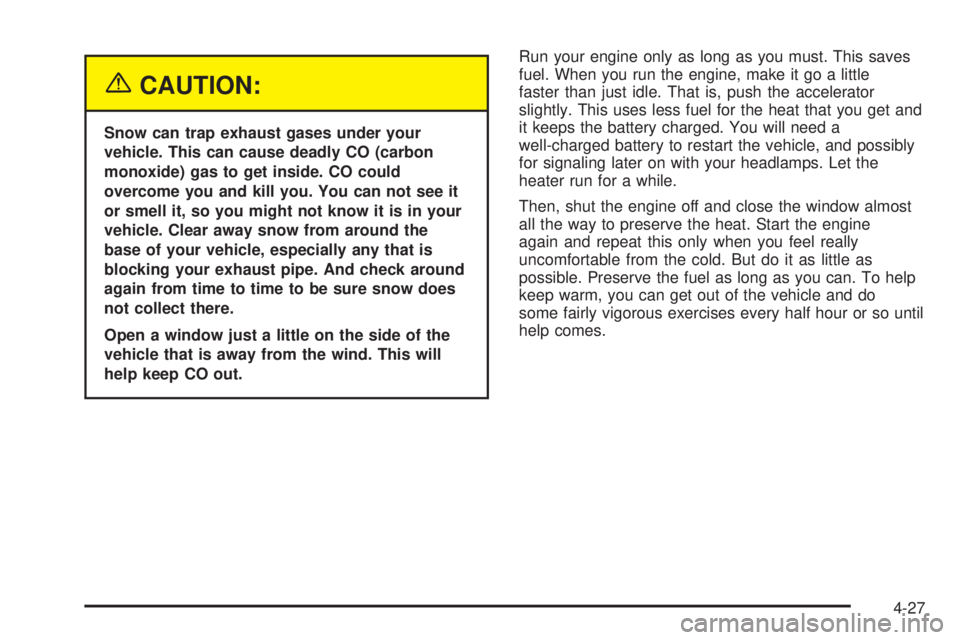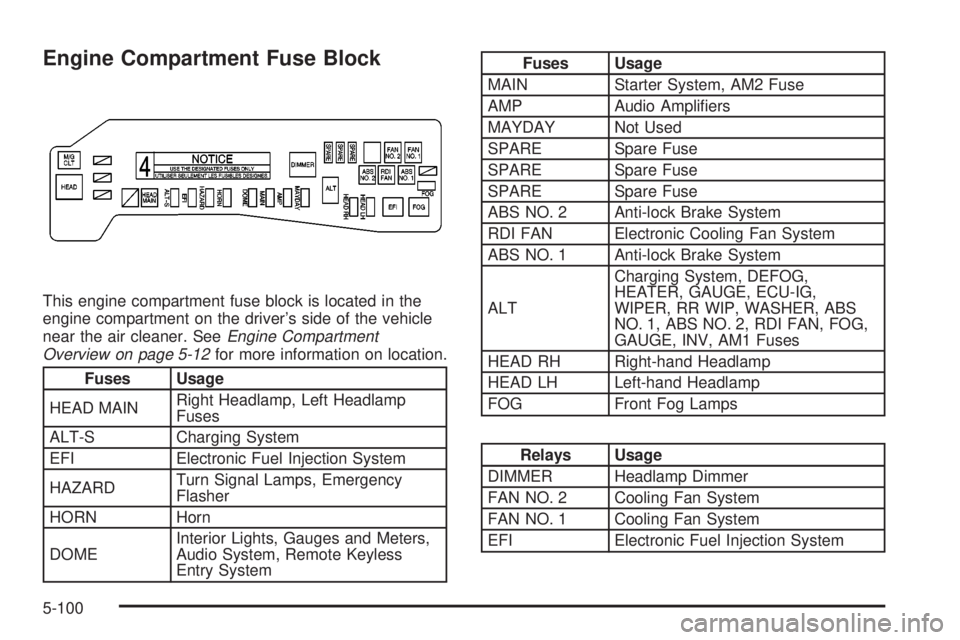heater PONTIAC VIBE 2004 Owners Manual
[x] Cancel search | Manufacturer: PONTIAC, Model Year: 2004, Model line: VIBE, Model: PONTIAC VIBE 2004Pages: 370, PDF Size: 2.68 MB
Page 65 of 370

Keys...............................................................2-2
Remote Keyless Entry System.........................2-4
Remote Keyless Entry System Operation...........2-5
Doors and Locks.............................................2-7
Door Locks....................................................2-7
Power Door Locks..........................................2-8
Rear Door Security Locks................................2-8
Leaving Your Vehicle......................................2-9
Liftgate/Liftglass.............................................2-9
Windows........................................................2-11
Manual Windows..........................................2-11
Power Windows............................................2-12
Sun Visors...................................................2-13
Theft-Deterrent Systems..................................2-13
Content Theft-Deterrent.................................2-13
Starting and Operating Your Vehicle................2-16
New Vehicle Break-In....................................2-16
Ignition Positions..........................................2-16
Starting Your Engine.....................................2-18
Engine Coolant Heater..................................2-19
Automatic Transaxle Operation.......................2-20
Manual Transaxle Operation...........................2-23
Parking Brake..............................................2-27Shifting Into Park (P).....................................2-28
Shifting Out of Park (P).................................2-30
Parking Your Vehicle.....................................2-31
Parking Over Things That Burn.......................2-32
Engine Exhaust............................................2-33
Running Your Engine While You Are Parked. . . .2-34
Mirrors...........................................................2-35
Manual Rearview Mirror.................................2-35
Outside Remote Control Mirrors......................2-36
Outside Convex Mirror...................................2-36
Storage Areas................................................2-37
Glove Box...................................................2-37
Cupholder(s)................................................2-37
Coinholder(s)................................................2-37
Instrument Panel Storage Area.......................2-37
Center Console Storage Area.........................2-37
Floor Mats...................................................2-37
Luggage Carrier...........................................2-38
Rear Storage Area........................................2-40
Rear Cargo Accessory Track System...............2-40
Cargo Cover................................................2-41
Sunroof.........................................................2-42
Section 2 Features and Controls
2-1
Page 83 of 370

Engine Coolant Heater
In very cold weather, 0ÉF (-18ÉC) or colder, the engine
coolant heater, if equipped, can help. You'll get
easier starting and better fuel economy during engine
warm-up. Usually, the coolant heater should be plugged
in a minimum of four hours prior to starting your
vehicle. At temperatures above 32ÉF (0ÉC), use of the
coolant heater is not required.
To Use the Engine Coolant Heater
1. Turn off the engine.
2. Open the hood and unwrap the electrical cord
located on the driver's side of the engine
compartment, near the front.
3. Plug it into a normal, grounded 110-volt AC outlet.
{CAUTION:
Plugging the cord into an ungrounded outlet
could cause an electrical shock. Also, the
wrong kind of extension cord could overheat
and cause a ®re. You could be seriously
injured. Plug the cord into a properly grounded
three-prong 110-volt AC outlet. If the cord
won't reach, use a heavy-duty three-prong
extension cord rated for at least 15 amps.
4. Before starting the engine, be sure to unplug and
store the cord as it was before to keep it away
from moving engine parts. If you don't, it could be
damaged.
How long should you keep the coolant heater plugged
in? The answer depends on the outside temperature, the
kind of oil you have, and some other things. Instead
of trying to list everything here, we ask that you contact
your dealer in the area where you'll be parking your
vehicle. The dealer can give you the best advice for that
particular area.
2-19
Page 197 of 370

{CAUTION:
Snow can trap exhaust gases under your
vehicle. This can cause deadly CO (carbon
monoxide) gas to get inside. CO could
overcome you and kill you. You can not see it
or smell it, so you might not know it is in your
vehicle. Clear away snow from around the
base of your vehicle, especially any that is
blocking your exhaust pipe. And check around
again from time to time to be sure snow does
not collect there.
Open a window just a little on the side of the
vehicle that is away from the wind. This will
help keep CO out.Run your engine only as long as you must. This saves
fuel. When you run the engine, make it go a little
faster than just idle. That is, push the accelerator
slightly. This uses less fuel for the heat that you get and
it keeps the battery charged. You will need a
well-charged battery to restart the vehicle, and possibly
for signaling later on with your headlamps. Let the
heater run for a while.
Then, shut the engine off and close the window almost
all the way to preserve the heat. Start the engine
again and repeat this only when you feel really
uncomfortable from the cold. But do it as little as
possible. Preserve the fuel as long as you can. To help
keep warm, you can get out of the vehicle and do
some fairly vigorous exercises every half hour or so until
help comes.
4-27
Page 238 of 370

What to Use
Use a mixture of one-halfclean, drinkable waterand
one-half half coolant that meets GM
Speci®cation 1825-M, which won't damage aluminum
parts. You can also use a recycled coolant conforming to
GM Speci®cation 1825-M with a complete coolant
¯ush and re®ll. If you use this coolant mixture, you don't
need to add anything else.
{CAUTION:
Adding only plain water to your cooling
system can be dangerous. Plain water, or
some other liquid such as alcohol, can boil
before the proper coolant mixture will. Your
vehicle's coolant warning system is set for the
proper coolant mixture. With plain water or the
wrong mixture, your engine could get too hot
but you wouldn't get the overheat warning.
Your engine could catch ®re and you or others
could be burned. Use a 50/50 mixture of clean,
drinkable water and the proper coolant.
Notice:If you use an improper coolant mixture,
your engine could overheat and be badly damaged.
The repair cost wouldn't be covered by your
warranty. Too much water in the mixture can freeze
and crack the engine, radiator, heater core and
other parts.
If you have to add coolant more than four times a year,
have your dealer check your cooling system.
Notice:If you use the proper coolant, you don't
have to add extra inhibitors or additives which claim
to improve the system. These can be harmful.
Checking Coolant
The vehicle must be on a
level surface. When your
engine is cold, the
coolant level should be at
LOW, or a little higher.
When your engine is warm,
the level should be up to
FULL, or a little higher.
5-28
Page 241 of 370

If No Steam Is Coming From Your
Engine
If you get an engine overheat warning but see or hear
no steam, the problem may not be too serious.
Sometimes the engine can get a little too hot when you:
·Climb a long hill on a hot day.
·Stop after high-speed driving.
·Idle for long periods in traffic.
·Tow a trailer.
If you get the overheat warning with no sign of steam,
try this for a minute or so:
1. In heavy traffic, let the engine idle in NEUTRAL (N)
while stopped. If it is safe to do so, pull off the road,
shift to PARK (P) or NEUTRAL (N) and let the
engine idle.
2. Turn on your heater to full hot at the highest fan
speed and open the window as necessary.If you no longer have the overheat warning, you can
drive. Just to be safe, drive slower for about 10 minutes.
If the warning doesn't come back on, you can drive
normally.
If the warning continues and you have not stopped, pull
over, stop, and park your vehicle right away.
If there's still no sign of steam, you can idle the engine
for three minutes while you're parked. If you still
have the warning,
turn off the engine and get everyone
out of the vehicleuntil it cools down.
You may decide not to lift the hood but to get service
help right away.
5-31
Page 243 of 370

The coolant level should
be at or above the FULL
mark. If it isn't, you
may have a leak at the
pressure cap or in
the radiator hoses, heater
hoses, radiator, water
pump or somewhere else
in the cooling system.
{CAUTION:
Heater and radiator hoses, and other engine
parts, can be very hot. Do not touch them. If
you do, you can be burned.
Do not run the engine if there is a leak. If you
run the engine, it could lose all coolant. That
could cause an engine ®re, and you could be
burned. Get any leak ®xed before you drive the
vehicle.
If there seems to be no leak, with the engine on, check
to see if the electric engine cooling fan is running. If
the engine is overheating, the fan should be running. If
it isn't, your vehicle needs service.
Notice:Engine damage from running your engine
without coolant isn't covered by your warranty.
5-33
Page 244 of 370

How to Add Coolant to the Coolant
Recovery Tank
If you haven't found a problem yet, but the coolant level
isn't at or above the FULL mark, add a 50/50 mixture
of
clean, drinkable waterand a proper coolant at
the coolant recovery tank. SeeEngine Coolant on
page 5-27for more information about the proper coolant
mixture.
{CAUTION:
Adding only plain water to your cooling
system can be dangerous. Plain water, or
some other liquid such as alcohol, can boil
before the proper coolant mixture will. Your
vehicle's coolant warning system is set for the
proper coolant mixture. With plain water or the
wrong mixture, your engine could get too hot
but you wouldn't get the overheat warning.
Your engine could catch ®re and you or others
could be burned. Use a 50/50 mixture of clean,
drinkable water and a proper coolant.
Notice:In cold weather, water can freeze and crack
the engine, radiator, heater core and other parts.
Use the recommended coolant and the proper
coolant mixture.
5-34
Page 310 of 370

Engine Compartment Fuse Block
This engine compartment fuse block is located in the
engine compartment on the driver's side of the vehicle
near the air cleaner. See
Engine Compartment
Overview on page 5-12for more information on location.
Fuses Usage
HEAD MAINRight Headlamp, Left Headlamp
Fuses
ALT-S Charging System
EFI Electronic Fuel Injection System
HAZARDTurn Signal Lamps, Emergency
Flasher
HORN Horn
DOMEInterior Lights, Gauges and Meters,
Audio System, Remote Keyless
Entry System
Fuses Usage
MAIN Starter System, AM2 Fuse
AMP Audio Ampli®ers
MAYDAY Not Used
SPARE Spare Fuse
SPARE Spare Fuse
SPARE Spare Fuse
ABS NO. 2 Anti-lock Brake System
RDI FAN Electronic Cooling Fan System
ABS NO. 1 Anti-lock Brake System
ALTCharging System, DEFOG,
HEATER, GAUGE, ECU-IG,
WIPER, RR WIP, WASHER, ABS
NO. 1, ABS NO. 2, RDI FAN, FOG,
GAUGE, INV, AM1 Fuses
HEAD RH Right-hand Headlamp
HEAD LH Left-hand Headlamp
FOG Front Fog Lamps
Relays Usage
DIMMER Headlamp Dimmer
FAN NO. 2 Cooling Fan System
FAN NO. 1 Cooling Fan System
EFI Electronic Fuel Injection System
5-100
Page 359 of 370

Child Restraints..............................................1-33
Child Restraint Systems...............................1-33
Infants and Young Children...........................1-29
Lower Anchorages and Top Tethers for
Children (LATCH System)..........................1-39
Older Children.............................................1-27
Securing a Child Restraint Designed for the
LATCH System........................................1-41
Securing a Child Restraint in a Rear Seat
Position..................................................1-42
Securing a Child Restraint in the Right Front
Seat Position...........................................1-44
Top Strap...................................................1-36
Top Strap Anchor Location............................1-38
Where to Put the Restraint...........................1-36
Cigarette Lighter.............................................3-19
Cleaning........................................................5-89
Inside of Your Vehicle..................................5-89
Outside of Your Vehicle................................5-92
Underbody Maintenance...............................5-95
Weatherstrips..............................................5-92
Cleaning Exterior Lamps/Lenses.......................5-93
Cleaning Fabric/Carpet....................................5-89
Cleaning Glass Surfaces..................................5-91
Cleaning Interior Plastic Components.................5-91
Cleaning Leather............................................5-91
Cleaning the Top of the Instrument Panel...........5-91
Cleaning Vinyl................................................5-91Climate Control System...................................3-19
Air Filter, Passenger Compartment.................3-23
Outlet Adjustment........................................3-22
Clutch, Hydraulic.............................................5-26
Coinholder(s)..................................................2-37
Compact Disc Messages..........................3-51, 3-62
Compact Spare Tire........................................5-88
Content Theft-Deferrent....................................2-13
Control of a Vehicle.......................................... 4-5
Coolant.........................................................3-33
Engine Temperature Gage............................3-33
Heater, Engine............................................2-19
Cooling System..............................................5-32
Cruise Control.................................................. 3-8
Cruise Control Light........................................3-39
Cupholder(s)..................................................2-37
Current and Past Model Order Forms................7-12
Customer Assistance Information........................ 7-8
Courtesy Transportation.................................. 7-8
Customer Assistance for Text
Telephone (TTY) Users............................... 7-4
Customer Assistance Offices........................... 7-4
Customer Satisfaction Procedure..................... 7-2
GM Mobility Program for Persons with
Disabilities................................................ 7-6
Reporting Safety Defects to General Motors....7-11
Reporting Safety Defects to the Canadian
Government............................................7-10
3
Page 360 of 370

Customer Assistance Information (cont.)
Reporting Safety Defects to the United States
Government............................................7-10
Roadside Assistance Program......................... 7-6
Service Publications Ordering Information........7-11
D
Daytime Running Lamps..................................3-13
Defensive Driving............................................. 4-2
Defogging and Defrosting.................................3-21
Dinghy Towing................................................4-31
Disarming the System.....................................2-15
Doing Your Own Service Work........................... 5-3
Dolly Towing..................................................4-32
Door.............................................................3-39
Ajar Light...................................................3-39
Locks.......................................................... 2-7
Power Door Locks......................................... 2-8
Rear Door Security Locks............................... 2-8
Driver............................................................1-14
Position, Safety Belt.....................................1-14
Seat Height Adjuster...................................... 1-3
Driving..........................................................4-15
At Night.....................................................4-15
City...........................................................4-19
Defensive..................................................... 4-2
Drunken....................................................... 4-2
Freeway.....................................................4-20Driving (cont.)
Hill and Mountain Roads..............................4-22
In Rain and on Wet Roads...........................4-16
Winter........................................................4-24
Driving On Grades..........................................4-39
Driving on Snow or Ice....................................4-24
Driving Through Deep Standing Water...............4-18
Driving Through Flowing Water.........................4-18
Driving with a Trailer.......................................4-38
E
Electrical System............................................5-97
Add-On Equipment......................................5-97
Fuses and Circuit Breakers...........................5-98
Headlamp Wiring.........................................5-98
Power Windows and Other Power Options......5-98
Windshield Wiper Fuses...............................5-98
Emissions Inspection and Maintenance
Programs...................................................3-37
Engine..........................................................5-21
Air Cleaner/Filter.........................................5-21
Battery.......................................................5-44
Check and Service Engine Soon Light............3-34
Coolant Heater............................................2-19
Coolant Temperature Gage...........................3-33
Coolant......................................................5-27
Cooling System Inspection............................6-25
Engine Compartment Overview......................5-12
4